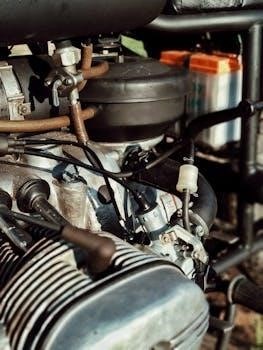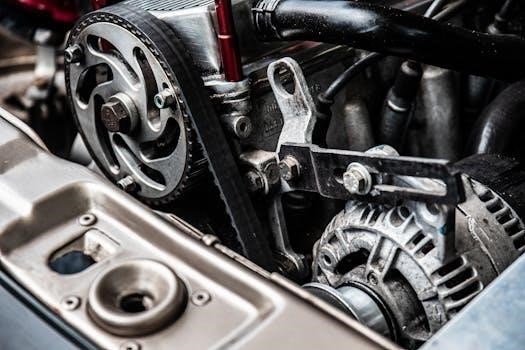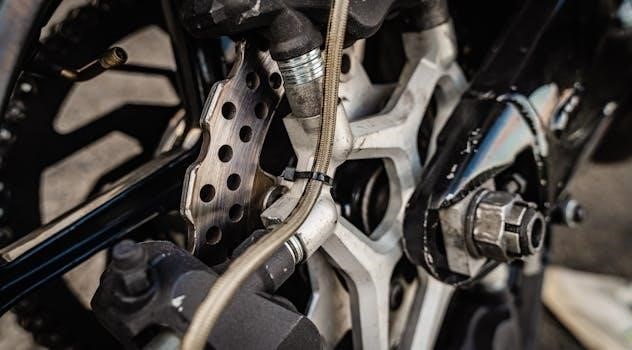Auto parts interchange databases are essential tools that list compatible parts across different vehicle makes and models. These resources, often digital, help users find alternative, interchangeable parts, sometimes even from older vehicles, for repairs and maintenance.
Understanding the Concept of Interchangeable Auto Parts
Interchangeable auto parts refer to components that, despite being designed for different vehicle models or manufacturers, can be used as direct replacements for one another. This is possible because many auto parts share similar specifications, dimensions, and functionalities across various vehicles. The concept is crucial in the automotive aftermarket, allowing for more cost-effective repairs and easier access to parts, especially for older or less common vehicles. These interchangeable parts might originate from different makes, models, or years, but they are engineered to perform the same function within a specific system. Identifying these parts relies on detailed cross-referencing, which is where the interchange databases become invaluable, providing alternative options when the original part is unavailable or too expensive.
The Importance of Auto Parts Interchange Databases
Auto parts interchange databases are critical for various stakeholders in the automotive industry. For vehicle owners, these databases facilitate cost savings by identifying less expensive, compatible alternatives to original parts, particularly when dealing with older or rare models. Repair shops and mechanics rely on these resources to efficiently locate parts and complete jobs quickly. For parts suppliers, such databases streamline inventory management by accurately identifying what parts will fit and be needed. These databases also promote sustainability by encouraging the reuse of parts from salvaged vehicles. Moreover, they enhance the scope of the aftermarket, providing access to a broader array of options and fostering competition among suppliers. Accurate and comprehensive interchange databases are therefore crucial for both cost-effectiveness and efficiency in the automotive sector.

Key Features of a Free Auto Parts Interchange Database
Free databases should offer robust search, filtering by vehicle specifics like make, model, and year, and also have comprehensive information on part interchange, ensuring data accuracy and availability.
Search Functionality and Filtering Options
A critical aspect of any free auto parts interchange database is its search functionality. Users must be able to quickly and easily locate the specific parts they need. This involves the ability to search using various criteria such as part numbers, vehicle identification numbers (VIN), or specific keywords describing the part. Furthermore, robust filtering options are essential for refining searches. These filters should include vehicle make, model, year, and potentially trim levels, engine types, and other relevant specifications. The ability to filter by specific part categories, like engine, transmission, or suspension, is also crucial. Advanced search features might also include the capacity to search for specific manufacturers or brands. The easier and more precise the search and filtering options, the more valuable the database becomes for users seeking compatible parts.
Data Accuracy and Completeness
The reliability of a free auto parts interchange database hinges significantly on its data accuracy and completeness. The database must provide accurate cross-references between original equipment manufacturer (OEM) part numbers and their interchangeable counterparts. Inaccurate data can lead to incorrect part purchases, causing wasted time, resources, and potentially even damage to vehicles. Completeness also plays a crucial role. The database should ideally cover a wide range of vehicle makes, models, and years, including older and less common vehicles. Furthermore, it should encompass various types of parts, from small components to major assemblies. A database lacking in this regard might not be able to provide the necessary information for all vehicles or part needs, limiting its overall utility. Therefore, the quality and extent of the data are paramount for user satisfaction.

Utilizing Auto Parts Interchange Databases
These databases allow users to find compatible parts across different vehicles, identify alternatives, and save money on repairs. They aid in locating used parts and expanding repair options.
Finding Compatible Parts for Your Vehicle
Locating the right auto parts for your vehicle can often feel like navigating a maze, but a free auto parts interchange database simplifies this process significantly. These databases act as comprehensive directories, allowing you to input your vehicle’s specifications—make, model, and year—to uncover a list of parts that are a direct fit or compatible substitutes. By cross-referencing original equipment manufacturer (OEM) part numbers, these databases reveal interchangeable parts from various brands and even different vehicle models. This means you’re not limited to just the parts originally designed for your specific vehicle. This feature is particularly valuable when dealing with older or less common vehicles where finding exact replacement parts can be a challenge. These databases help ensure you find the correct component, saving time and potentially money.
Identifying Alternative Parts and Cost Savings
Free auto parts interchange databases are invaluable for identifying alternative parts, opening up avenues for significant cost savings. These databases reveal options beyond the original manufacturer, often including parts from different makes and models that are functionally equivalent. By presenting a range of choices, users can select more affordable parts, potentially from aftermarket suppliers or used components; This is especially useful when dealing with older vehicles where original parts may be scarce or expensive. The ability to cross-reference part numbers also ensures the selected alternative is the correct fit, avoiding costly mistakes. Furthermore, access to a wider range of parts can help users avoid the high prices of OEM parts, which often leads to substantial reductions in repair and maintenance expenses.

Challenges and Limitations of Free Databases
Free databases can suffer from inaccuracies and outdated information, affecting the reliability of interchange data. Limited coverage and availability may also restrict the scope of usable data.
Potential for Inaccuracies and Outdated Information
Free auto parts interchange databases, while convenient, often present challenges regarding data accuracy. Information can be outdated due to the constant introduction of new vehicle models and parts. The absence of rigorous update processes means that listed interchanges might not reflect the most current compatibility standards. This can lead to the selection of parts that are not suitable for a vehicle, resulting in potential damage or safety issues. Reliance on user-submitted data or less comprehensive sources can further contribute to these inaccuracies, making it crucial for users to cross-reference information with other sources. The lack of professional oversight and verification processes in free databases poses a risk for those seeking reliable interchange data.
Database Coverage and Availability
Free auto parts interchange databases often suffer limitations in terms of their coverage. Many might not include a comprehensive selection of vehicle models, especially older or less common ones. This limited scope can make finding interchangeable parts for specific vehicles difficult. Availability can also be a concern, as some free databases may not be consistently accessible or might have limited uptime. The lack of extensive resources can also mean that data for certain parts or components may be missing. Users may also discover that the database does not offer information for specific brands, leading to frustration. Therefore, relying solely on one free database could restrict options when searching for compatible auto parts. The inconsistent nature of availability impacts the overall reliability of these free resources.

Popular Auto Parts Interchange Resources
Many online databases and tools are available, offering free access to parts interchange information. The legacy of the Hollander Interchange remains a significant influence in this field, providing a valuable resource for users.
Online Databases and Tools
Numerous online platforms offer free access to auto parts interchange data. These tools often feature search functionalities, allowing users to input specific vehicle details or part numbers to find compatible alternatives. Websites like Autozone.com offer vehicle fitment lists, showing all vehicles a particular part was installed on. Some databases provide cross-references between OEM and aftermarket part numbers, while others focus on used parts, referencing interchange information from salvage yards. Pull-A-Part’s online database is a great example, offering a fast and easy way to locate used parts. These resources are constantly updated, aiming to provide the most accurate and comprehensive data possible for various automotive parts.
The Legacy of the Hollander Interchange
The Hollander Interchange holds a significant place in the history of auto parts. Originating during the Great Depression, Roy and Hildur Hollander meticulously compiled a list of interchangeable auto parts. This list evolved into what is now known as The Hollander Interchange, which remains a widely utilized database. It serves as a crucial resource for identifying compatible parts across different vehicle makes and models, particularly in the used parts market. The Hollander Interchange’s legacy underscores the importance of accurate cross-referencing for auto repair and maintenance, setting a standard for the industry that continues to influence modern parts databases and tools.
